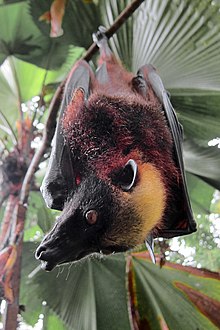Acerodon jubatus
| Giant golden-crowned flying fox | |
|---|---|
 |
|
| Scientific classification | |
| Kingdom: | Animalia |
| Phylum: | Chordata |
| Class: | Mammalia |
| Order: | Chiroptera |
| Family: | Pteropodidae |
| Genus: | Acerodon |
| Species: | A. jubatus |
| Binomial name | |
|
Acerodon jubatus (Eschscholtz, 1831) |
|
 |
|
| Giant golden-crowned flying fox range (green — extant, orange — possibly extirpated, black — extirpated) |
|
The giant golden-crowned flying fox (Acerodon jubatus), also known as the golden-capped fruit bat, is a rare megabat and one of the largest bats in the world. The species is endangered and is currently facing the possibility of extinction because of poaching and forest destruction. It is endemic to forests in the Philippines. The bat can reach up to 1.2 kg (2.6 lb) in weight and 1.7 m (5.6 ft) in wingspan. Like other megabats, this species is non-aggressive towards humans and is frugivorous. Even though they are not aggressive, handling the bat without proper training and vaccination is dangerous, as some can carry deadly diseases.
The giant golden-crowned flying fox gets its species name from the golden fur around the head, in sharp contrast to the black body. Like all other fruit bats, they have no tail. They are among the largest bats, with a wingspan of 1.5–1.7 metres (4 ft 11 in–5 ft 7 in) and weighing 0.7–1.2 kilograms (1.5–2.6 lb). The only other bats with similar dimensions are a few species of Pteropus.
Recent surveys have found A. jubatus roosting with P. vampyrus on the islands of Bohol, Boracay, Cebu, Leyte, Luzon, Mindanao, Mindoro, Negros and Polillo.
The giant golden-crowned flying fox is confined to the forests of the Philippines, where it occurs mostly at elevations from sea level to 1,100 m (3,600 ft). It prefers uninhabited areas. A 2005 study found none in inhabited areas. The same study also revealed that these bats use river corridors called riparian zones more than originally thought, because the fig trees located near rivers are the bats' main source of food. They like to be close to agricultural fields, but only in undisturbed forest areas.
...
Wikipedia

